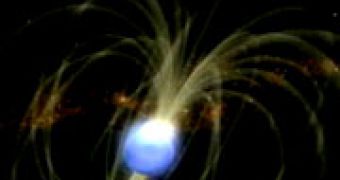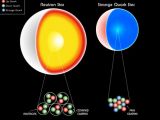As a star consumes its fuel of protons, it generates more and more neutrons. Some of the large stars explode as supernovas, a process that creates virtually all the types of atoms that exist in the Universe, and leave behind neutron stars - stars composed mainly from neutrons. The even larger stars leave behind black-holes.
Neutrons and protons are the components of atomic nuclei and they are made of quarks. As I have described in another article on the nature of the proton, besides the 'up' and 'down' quarks there are also some less permanent quarks, called 'strange' quarks. These come in and out of existence, but it was proved that, at least in case of the proton, they do influence the particle's properties. What happens in case of protons also happens in case of neutrons.
But there is more: A new study recently published in Physical Review Letters suggests that neutron stars may gradually transform into 'strange' stars - i.e. in stars made up primarily from the 'strange' quark. Normal matter is composed mainly of 'up' and 'down' quarks. Strange matter is composed mainly of 'strange' quarks binding together.
The conventional wisdom is that the electric field of a such a hypothetical strange star (made up from strange matter) at its surface would be so huge and its luminosity so big that it would be impossible to confuse it with anything else. However, Prashanth Jaikumar and his fellow researchers from the Argonne National Laboratory in Illinois, and his two partners from Los Alamos National Laboratory in New Mexico want to challenge that.
Working with Sanjay Reddy and Andrew W. Steiner, Jaikumar has developed a new theory about what a strange star would look like.
"We haven't found strange stars yet," Jaikumar explains. "But that doesn't mean they don't exist. Maybe we have found them. Maybe some of these neutron stars are really strange stars. According to our theory, it would be very difficult to tell a strange star from a neutron star."
One of the most interesting aspects of neutron stars is that they are not gaseous like usual stars, but they are so closely packed that they are liquid. Strange stars should also be liquid. But the difficult question is: How does the surface of these stars look like? One common assumption is that the surface is solid.
However, Jaikumar and his colleagues challenge that. Strange stars are usually assumed to exhibit huge electric fields on their surface precisely because they are assumed to have a smooth surface. But according to the scientists neither neutron stars nor strange stars have such a smooth solid-like surface.
"It's like taking water," Jaikumar says, "with a flat surface. Add detergent and it reduces surface tension, allowing bubbles to form. In a strange star, the bubbles are made of strange quark matter, and float in a sea of electrons. Consequently, the star's surface may be crusty, not smooth. The effect of surface tension had been overlooked before."
One consequence is that a strange star wouldn't have large electrical field at surface or be super-luminous. It also allows for a strange star to be less dense than originally thought - although such stars are definitely unusually dense compared to regular stars (imagine a star twice as heavy as our Sun but only 20 km wide!).
One important issue is whether at high density 'strange' quark matter is more stable than regular matter (which is comprised of 'up' and 'down' quarks). Jaikumar believes so, and he and his colleagues think that as a neutron star spins down and its core density increases, it may convert into the more stable state of strange quark matter, thus forming a strange star.
Unfortunately it is very difficult to obtain exact numbers from the theory of Quantum Chromodynamics (QCD) - which is the fundamental theory of quarks. This difficulty resides less with the theory itself and more with the insufficient computing power of current computers. "The uncertainties are large enough that we are unable to form a conclusive statement on whether these nuggets could actually form. We want to be able to quantify the assumptions better."
Thus, insofar theorists cannot say with absolute certainty whether or not a neutron star does indeed gradually convert into a strange star. However, they have managed to describe how a strange star could be told apart from a neutron star.
According to Jaikumar, making the distinction is rather tricky: "There might be a slight difference. You'd look at surface temperature and see how stars are cooling in time. If it is quark matter, the emission rates are different, so the strange star may cool a little faster."
Now it's the astronomers' job to discover whether strange stars exist or not. Either discovery will have important implications for the QCD theory. "Finding a strange star would improve our understanding of QCD, the fundamental theory of the nuclear force. And it would also be the first solid evidence of stable quark matter", Jaikumar said.

 14 DAY TRIAL //
14 DAY TRIAL // 
